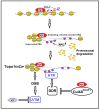The Complex Interactions Between HIV-1 and Human Host Cell Genome: From Molecular Mechanisms to Clinical Practice
- PMID: 40244051
- PMCID: PMC11989121
- DOI: 10.3390/ijms26073184
The Complex Interactions Between HIV-1 and Human Host Cell Genome: From Molecular Mechanisms to Clinical Practice
Abstract
Antiretroviral therapy (ART) has significantly improved the prognosis of human immunodeficiency virus type 1 (HIV-1) infection. Although ART can suppress plasma viremia below detectable levels, it cannot eradicate the HIV-1 DNA (provirus) integrated into the host cell genome. This integration often results in unrepaired DNA damage due to the HIV-1-induced inhibition of DNA repair pathways. Furthermore, HIV-1 infection causes telomere attrition in host chromosomes, a critical factor contributing to CD4+ T cell senescence and apoptosis. HIV-1 proteins can induce DNA damage, block DNA replication, and activate DNA damage responses across various organs. In this review, we explore multiple aspects of the intricate interactions between HIV-1 and the host genome involved in CD4+ T cell depletion, inflammaging, the clonal expansion of infected cells in long-term-treated patients, and viral latency. We discuss the molecular mechanisms of DNA damage that contribute to comorbidities in HIV-1-infected individuals and highlight emerging therapeutic strategies targeting the integrated HIV-1 provirus.
Keywords: CPSF6; DNA damage; HIV-1; HIV-1 therapies; LEDGF/p75; capsid; latency; viral DNA integration; virus–host interaction.
Conflict of interest statement
The authors declare no conflicts of interest.
Figures





Similar articles
-
Posttranscriptional Regulation of HIV-1 Gene Expression during Replication and Reactivation from Latency by Nuclear Matrix Protein MATR3.mBio. 2018 Nov 13;9(6):e02158-18. doi: 10.1128/mBio.02158-18. mBio. 2018. PMID: 30425153 Free PMC article.
-
A Two-Color Haploid Genetic Screen Identifies Novel Host Factors Involved in HIV-1 Latency.mBio. 2021 Dec 21;12(6):e0298021. doi: 10.1128/mBio.02980-21. Epub 2021 Dec 7. mBio. 2021. PMID: 34872356 Free PMC article.
-
The role of integration and clonal expansion in HIV infection: live long and prosper.Retrovirology. 2018 Oct 23;15(1):71. doi: 10.1186/s12977-018-0448-8. Retrovirology. 2018. PMID: 30352600 Free PMC article. Review.
-
New Approaches to Multi-Parametric HIV-1 Genetics Using Multiple Displacement Amplification: Determining the What, How, and Where of the HIV-1 Reservoir.Viruses. 2021 Dec 10;13(12):2475. doi: 10.3390/v13122475. Viruses. 2021. PMID: 34960744 Free PMC article. Review.
-
Naf1 Regulates HIV-1 Latency by Suppressing Viral Promoter-Driven Gene Expression in Primary CD4+ T Cells.J Virol. 2016 Dec 16;91(1):e01830-16. doi: 10.1128/JVI.01830-16. Print 2017 Jan 1. J Virol. 2016. PMID: 27795436 Free PMC article.
Cited by
-
Oxidative Stress in HIV-Associated Neurodegeneration: Mechanisms of Pathogenesis and Therapeutic Targets.Int J Mol Sci. 2025 Jul 13;26(14):6724. doi: 10.3390/ijms26146724. Int J Mol Sci. 2025. PMID: 40724974 Free PMC article. Review.
References
-
- Dopkins N., O’Mara M.M., Lawrence E., Fei T., Sandoval-Motta S., Nixon D.F., Bendall M.L. A field guide to endogenous retrovirus regulatory networks. Mol. Cell. 2022;82:3763–3768. - PubMed
Publication types
MeSH terms
LinkOut - more resources
Full Text Sources
Medical
Research Materials

